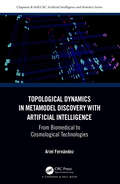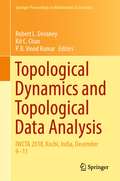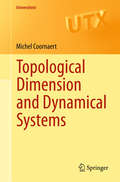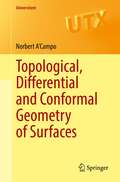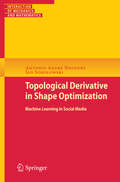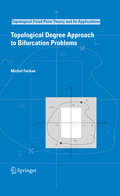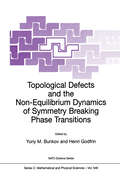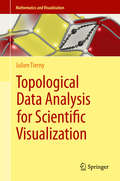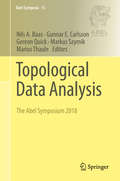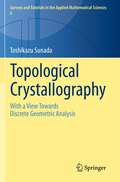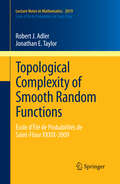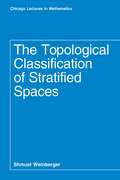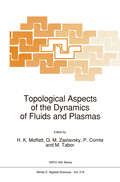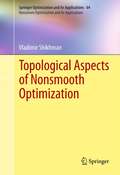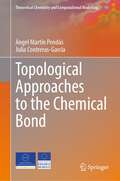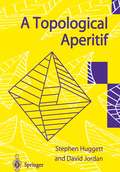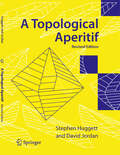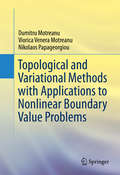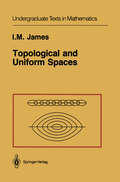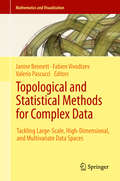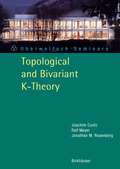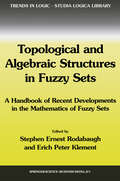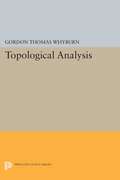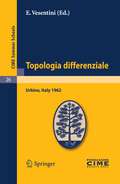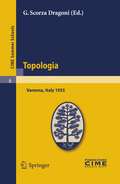- Table View
- List View
Topological Dynamics in Metamodel Discovery with Artificial Intelligence: From Biomedical to Cosmological Technologies (Chapman & Hall/CRC Artificial Intelligence and Robotics Series)
by Ariel FernándezThe leveraging of artificial intelligence (AI) for model discovery in dynamical systems is cross-fertilizing and revolutionizing both disciplines, heralding a new era of data-driven science. This book is placed at the forefront of this endeavor, taking model discovery to the next level. Dealing with artificial intelligence, this book delineates AI’s role in model discovery for dynamical systems. With the implementation of topological methods to construct metamodels, it engages with levels of complexity and multiscale hierarchies hitherto considered off limits for data science. Key Features: Introduces new and advanced methods of model discovery for time series data using artificial intelligence Implements topological approaches to distill "machine-intuitive" models from complex dynamics data Introduces a new paradigm for a parsimonious model of a dynamical system without resorting to differential equations Heralds a new era in data-driven science and engineering based on the operational concept of "computational intuition" Intended for graduate students, researchers, and practitioners interested in dynamical systems empowered by AI or machine learning and in their biological, engineering, and biomedical applications, this book will represent a significant educational resource for people engaged in AI-related cross-disciplinary projects.
Topological Dynamics and Topological Data Analysis: IWCTA 2018, Kochi, India, December 9–11 (Springer Proceedings in Mathematics & Statistics #350)
by Robert L. Devaney Kit C. Chan P. B. Vinod KumarThis book collects select papers presented at the International Workshop and Conference on Topology & Applications, held in Kochi, India, from 9–11 December 2018. The book discusses topics on topological dynamical systems and topological data analysis. Topics are ranging from general topology, algebraic topology, differential topology, fuzzy topology, topological dynamical systems, topological groups, linear dynamics, dynamics of operator network topology, iterated function systems and applications of topology. All contributing authors are eminent academicians, scientists, researchers and scholars in their respective fields, hailing from around the world. The book is a valuable resource for researchers, scientists and engineers from both academia and industry.
Topological Dimension and Dynamical Systems (Universitext)
by Michel CoornaertTranslated from the popular French edition, the goal of the book is to provide a self-contained introduction to mean topological dimension, an invariant of dynamical systems introduced in 1999 by Misha Gromov. The book examines how this invariant was successfully used by Elon Lindenstrauss and Benjamin Weiss to answer a long-standing open question about embeddings of minimal dynamical systems into shifts.A large number of revisions and additions have been made to the original text. Chapter 5 contains an entirely new section devoted to the Sorgenfrey line. Two chapters have also been added: Chapter 9 on amenable groups and Chapter 10 on mean topological dimension for continuous actions of countable amenable groups. These new chapters contain material that have never before appeared in textbook form. The chapter on amenable groups is based on Følner’s characterization of amenability and may be read independently from the rest of the book.Although the contents of this book lead directly to several active areas of current research in mathematics and mathematical physics, the prerequisites needed for reading it remain modest; essentially some familiarities with undergraduate point-set topology and, in order to access the final two chapters, some acquaintance with basic notions in group theory. Topological Dimension and Dynamical Systems is intended for graduate students, as well as researchers interested in topology and dynamical systems. Some of the topics treated in the book directly lead to research areas that remain to be explored.
Topological, Differential and Conformal Geometry of Surfaces (Universitext)
by Norbert A'CampoThis book provides an introduction to the main geometric structures that are carried by compact surfaces, with an emphasis on the classical theory of Riemann surfaces. It first covers the prerequisites, including the basics of differential forms, the Poincaré Lemma, the Morse Lemma, the classification of compact connected oriented surfaces, Stokes’ Theorem, fixed point theorems and rigidity theorems. There is also a novel presentation of planar hyperbolic geometry. Moving on to more advanced concepts, it covers topics such as Riemannian metrics, the isometric torsion-free connection on vector fields, the Ansatz of Koszul, the Gauss–Bonnet Theorem, and integrability. These concepts are then used for the study of Riemann surfaces. One of the focal points is the Uniformization Theorem for compact surfaces, an elementary proof of which is given via a property of the energy functional. Among numerous other results, there is also a proof of Chow’s Theorem on compact holomorphic submanifolds in complex projective spaces. Based on lecture courses given by the author, the book will be accessible to undergraduates and graduates interested in the analytic theory of Riemann surfaces.
Topological Derivatives in Shape Optimization (Interaction of Mechanics and Mathematics)
by Antonio André Novotny Jan SokołowskiThe topological derivative is defined as the first term (correction) of the asymptotic expansion of a given shape functional with respect to a small parameter that measures the size of singular domain perturbations, such as holes, inclusions, defects, source-terms and cracks. Over the last decade, topological asymptotic analysis has become a broad, rich and fascinating research area from both theoretical and numerical standpoints. It has applications in many different fields such as shape and topology optimization, inverse problems, imaging processing and mechanical modeling including synthesis and/or optimal design of microstructures, fracture mechanics sensitivity analysis and damage evolution modeling. Since there is no monograph on the subject at present, the authors provide here the first account of the theory which combines classical sensitivity analysis in shape optimization with asymptotic analysis by means of compound asymptotic expansions for elliptic boundary value problems. This book is intended for researchers and graduate students in applied mathematics and computational mechanics interested in any aspect of topological asymptotic analysis. In particular, it can be adopted as a textbook in advanced courses on the subject and shall be useful for readers interested on the mathematical aspects of topological asymptotic analysis as well as on applications of topological derivatives in computation mechanics.
Topological Degree Approach to Bifurcation Problems (Topological Fixed Point Theory and Its Applications #5)
by Michal Fečkan1. 1 Preface Many phenomena from physics, biology, chemistry and economics are modeled by di?erential equations with parameters. When a nonlinear equation is est- lished, its behavior/dynamics should be understood. In general, it is impossible to ?nd a complete dynamics of a nonlinear di?erential equation. Hence at least, either periodic or irregular/chaotic solutions are tried to be shown. So a pr- erty of a desired solution of a nonlinear equation is given as a parameterized boundary value problem. Consequently, the task is transformed to a solvability of an abstract nonlinear equation with parameters on a certain functional space. When a family of solutions of the abstract equation is known for some para- ters, the persistence or bifurcations of solutions from that family is studied as parameters are changing. There are several approaches to handle such nonl- ear bifurcation problems. One of them is a topological degree method, which is rather powerful in cases when nonlinearities are not enough smooth. The aim of this book is to present several original bifurcation results achieved by the author using the topological degree theory. The scope of the results is rather broad from showing periodic and chaotic behavior of non-smooth mechanical systems through the existence of traveling waves for ordinary di?erential eq- tions on in?nite lattices up to study periodic oscillations of undamped abstract waveequationsonHilbertspaceswithapplicationstononlinearbeamandstring partial di?erential equations. 1.
Topological Defects and the Non-Equilibrium Dynamics of Symmetry Breaking Phase Transitions (Nato Science Series C: #549)
by Yuriy M. Bunkov Henri GodfrinTopological defects formed at symmetry-breaking phase transitions play an important role in many different fields of physics. They appear in many condensed-matter systems at low temperature; examples include vortices in superfluid helium-4, a rich variety of defects in helium-3, quantized mag netic flux tubes in type-II superconductors, and disclination lines and other defects in liquid crystals. In cosmology, unified gauge theories of particle interactions suggest a sequence of phase transitions in the very early uni verse some of which may lead to defect formation. In astrophysics, defects play an important role in the dynamics of neutron stars. In 1997 the European Science Foundation started the scientific network "Topological defects" headed by Tom Kibble. This network has provided us with a unique opportunity of establishing a collaboration between the representatives of these very different branches of modern physics. The NATO-ASI (Advanced Study Institute), held in Les Houches in February 1999 thanks to the support of the Scientific Division of NATO, the European Science Foundation and the CNRS, represents a key event of this ESF network. It brought together participants from widely different fields, with diverse expertise and vocabulary, fostering the exchange of ideas. The lectures given by particle physicists, cosmologists and condensed matter physicists are the result of the fruitful collaborations established since 1997 between groups in several European countries and in the U.S.A.
Topological Data Analysis for Scientific Visualization (Mathematics and Visualization)
by Julien TiernyCombining theoretical and practical aspects of topology, this book provides a comprehensive and self-contained introduction to topological methods for the analysis and visualization of scientific data.Theoretical concepts are presented in a painstaking but intuitive manner, with numerous high-quality color illustrations. Key algorithms for the computation and simplification of topological data representations are described in detail, and their application is carefully demonstrated in a chapter dedicated to concrete use cases.With its fine balance between theory and practice, "Topological Data Analysis for Scientific Visualization" constitutes an appealing introduction to the increasingly important topic of topological data analysis for lecturers, students and researchers.
Topological Data Analysis: The Abel Symposium 2018 (Abel Symposia #15)
by Nils A. Baas Gunnar E. Carlsson Gereon Quick Markus Szymik Marius ThauleThis book gathers the proceedings of the 2018 Abel Symposium, which was held in Geiranger, Norway, on June 4-8, 2018. The symposium offered an overview of the emerging field of "Topological Data Analysis". This volume presents papers on various research directions, notably including applications in neuroscience, materials science, cancer biology, and immune response. Providing an essential snapshot of the status quo, it represents a valuable asset for practitioners and those considering entering the field.
Topological Crystallography: With a View Towards Discrete Geometric Analysis (Surveys and Tutorials in the Applied Mathematical Sciences #6)
by Toshikazu SunadaGeometry in ancient Greece is said to have originated in the curiosity of mathematicians about the shapes of crystals, with that curiosity culminating in the classification of regular convex polyhedra addressed in the final volume of Euclid’s Elements. Since then, geometry has taken its own path and the study of crystals has not been a central theme in mathematics, with the exception of Kepler’s work on snowflakes. Only in the nineteenth century did mathematics begin to play a role in crystallography as group theory came to be applied to the morphology of crystals. This monograph follows the Greek tradition in seeking beautiful shapes such as regular convex polyhedra. The primary aim is to convey to the reader how algebraic topology is effectively used to explore the rich world of crystal structures. Graph theory, homology theory, and the theory of covering maps are employed to introduce the notion of the topological crystal which retains, in the abstract, all the information on the connectivity of atoms in the crystal. For that reason the title Topological Crystallography has been chosen.Topological crystals can be described as “living in the logical world, not in space,” leading to the question of how to place or realize them “canonically” in space. Proposed here is the notion of standard realizations of topological crystals in space, including as typical examples the crystal structures of diamond and lonsdaleite. A mathematical view of the standard realizations is also provided by relating them to asymptotic behaviors of random walks and harmonic maps. Furthermore, it can be seen that a discrete analogue of algebraic geometry is linked to the standard realizations.Applications of the discussions in this volume include not only a systematic enumeration of crystal structures, an area of considerable scientific interest for many years, but also the architectural design of lightweight rigid structures. The reader therefore can see the agreement of theory and practice.
Topological Complexity of Smooth Random Functions: École d'Été de Probabilités de Saint-Flour XXXIX-2009 (Lecture Notes in Mathematics #2019)
by Robert Adler Jonathan E. TaylorThese notes, based on lectures delivered in Saint Flour, provide an easy introduction to the authors’ 2007 Springer monograph “Random Fields and Geometry.” While not as exhaustive as the full monograph, they are also less exhausting, while still covering the basic material, typically at a more intuitive and less technical level. They also cover some more recent material relating to random algebraic topology and statistical applications. The notes include an introduction to the general theory of Gaussian random fields, treating classical topics such as continuity and boundedness. This is followed by a quick review of geometry, both integral and Riemannian, with an emphasis on tube formulae, to provide the reader with the material needed to understand and use the Gaussian kinematic formula, the main result of the notes. This is followed by chapters on topological inference and random algebraic topology, both of which provide applications of the main results.
The Topological Classification of Stratified Spaces (Chicago Lectures in Mathematics)
by Shmuel WeinbergerThis book provides the theory for stratified spaces, along with important examples and applications, that is analogous to the surgery theory for manifolds. In the first expository account of this field, Weinberger provides topologists with a new way of looking at the classification theory of singular spaces with his original results. Divided into three parts, the book begins with an overview of modern high-dimensional manifold theory. Rather than including complete proofs of all theorems, Weinberger demonstrates key constructions, gives convenient formulations, and shows the usefulness of the technology. Part II offers the parallel theory for stratified spaces. Here, the topological category is most completely developed using the methods of "controlled topology." Many examples illustrating the topological invariance and noninvariance of obstructions and characteristic classes are provided. Applications for embeddings and immersions of manifolds, for the geometry of group actions, for algebraic varieties, and for rigidity theorems are found in Part III. This volume will be of interest to topologists, as well as mathematicians in other fields such as differential geometry, operator theory, and algebraic geometry.
Topological Aspects of the Dynamics of Fluids and Plasmas (NATO Science Series E: #218)
by H. K. Moffatt G. M. Zaslavsky P. Comte M. TaborThis volume contains papers arising out of the program of the Institute for Theoretical Physics (ITP) of the University of California at Santa Bar bara, August-December 1991, on the subject "Topological Fluid Dynamics". The first group of papers cover the lectures on Knot Theory, Relaxation un der Topological Constraints, Kinematics of Stretching, and Fast Dynamo Theory presented at the initial Pedagogical Workshop of the program. The remaining papers were presented at the subsequent NATO Advanced Re search Workshop or were written during the course of the program. We wish to acknowledge the support of the NATO Science Committee in making this workshop possible. The scope of "Topological Fluid Dynamics" was defined by an earlier Symposium of the International Union of Theoretical and Applied Mechan ics (IUTAM) held in Cambridge, England in August, 1989, the Proceedings of which were published (Eds. H.K. Moffatt and A. Tsinober) by Cambridge University Press in 1990. The proposal to hold an ITP program on this sub ject emerged from that Symposium, and we are grateful to John Greene and Charlie Kennel at whose encouragement the original proposal was formu lated. Topological fluid dynamics covers a range of problems, particularly those involving vortex tubes and/or magnetic flux tubes in nearly ideal fluids, for which topological structures can be identified and to some extent quantified.
Topological Aspects of Nonsmooth Optimization (Nonconvex Optimization and Its Applications #64)
by Vladimir ShikhmanThis book deals with nonsmooth structures arising within the optimization setting. It considers four optimization problems, namely, mathematical programs with complementarity constraints, general semi-infinite programming problems, mathematical programs with vanishing constraints and bilevel optimization. The author uses the topological approach and topological invariants of corresponding feasible sets are investigated. Moreover, the critical point theory in the sense of Morse is presented and parametric and stability issues are considered. The material progresses systematically and establishes a comprehensive theory for a rather broad class of optimization problems tailored to their particular type of nonsmoothness. Topological Aspects of Nonsmooth Optimization will benefit researchers and graduate students in applied mathematics, especially those working in optimization theory, nonsmooth analysis, algebraic topology and singularity theory.
Topological Approaches to the Chemical Bond (Theoretical Chemistry and Computational Modelling)
by Ángel Martín Pendás Julia Contreras-GarcíaThis graduate textbook provides comprehensive information on topological analysis in real space of the electronic structure. Application of the topological tools is becoming routine for understanding the outcome of quantum chemical calculations. This title thoroughly reviews a selection of currently available topological tools, their use and spectrum of applications and provides graduate students and researchers with information not easily obtained from the available textbooks. The book is accompanied by worked examples, exercises and solutions and is a great tool for any quantum chemistry or computational chemistry course at the graduate and advanced undergraduate levels.
A Topological Aperitif
by Stephen Huggett David JordanThis book takes a new look at the subject, choosing a geometric approach rather than the usual algebraic or combinatorial approach. It starts with a wealth of examples of how to be mathematically certain whether two objects are the same from the point of view of topology. After introducing surfaces, the book explores the properties of polyhedra drawn on these surfaces. More refined tools are developed in a chapter on winding number.
A Topological Aperitif
by Stephen Huggett David JordanTopologyhasbeenreferredtoas“rubber-sheetgeometry”.Thenameisapt,for the subject is concerned with properties of an object that would be preserved, no matter how much it is stretched, squashed, or distorted, so long as it is not in any way torn apart or glued together. One’s ?rst reaction might be that such animprecise-soundingsubjectcouldhardlybepartofseriousmathematics,and wouldbeunlikelytohaveapplicationsbeyondtheamusementofsimpleparlour games. This reaction could hardly be further from the truth. Topology is one of the most important and broad-ranging disciplines of modern mathematics. It is a subject of great precision and of breadth of development. It has vastly many applications, some of great importance, ranging from particle physics to cosmology, and from hydrodynamics to algebra and number theory. It is also a subject of great beauty and depth. To appreciate something of this, it is not necessary to delve into the more obscure aspects of mathematical formalism. For topology is, at least initially, a very visual subject. Some of its concepts apply to spaces of large numbers of dimensions, and therefore do not easily submit to reasoning that depends upon direct pictorial representation. But even in such cases, important insights can be obtained from the visual - rusal of a simple geometrical con?guration. Although much modern topology depends upon ?nely tuned abstract algebraic machinery of great mathematical sophistication, the underlying ideas are often very simple and can be appre- ated by the examination of properties of elementary-looking drawings.
Topological and Variational Methods with Applications to Nonlinear Boundary Value Problems
by Dumitru Motreanu Viorica Venera Motreanu Nikolaos PapageorgiouThis book focuses on nonlinear boundary value problems and the aspects of nonlinear analysis which are necessary to their study. The authors first give a comprehensive introduction to the many different classical methods from nonlinear analysis, variational principles, and Morse theory. They then provide a rigorous and detailed treatment of the relevant areas of nonlinear analysis with new applications to nonlinear boundary value problems for both ordinary and partial differential equations. Recent results on the existence and multiplicity of critical points for both smooth and nonsmooth functional, developments on the degree theory of monotone type operators, nonlinear maximum and comparison principles for p-Laplacian type operators, and new developments on nonlinear Neumann problems involving non-homogeneous differential operators appear for the first time in book form. The presentation is systematic, and an extensive bibliography and a remarks section at the end of each chapter highlight the text. This work will serve as an invaluable reference for researchers working in nonlinear analysis and partial differential equations as well as a useful tool for all those interested in the topics presented.
Topological and Uniform Spaces (Undergraduate Texts in Mathematics)
by I.M. JamesThis book is based on lectures I have given to undergraduate and graduate audiences at Oxford and elsewhere over the years. My aim has been to provide an outline of both the topological theory and the uniform theory, with an emphasis on the relation between the two. Although I hope that the prospec tive specialist may find it useful as an introduction it is the non-specialist I have had more in mind in selecting the contents. Thus I have tended to avoid the ingenious examples and counterexamples which often occupy much ofthe space in books on general topology, and I have tried to keep the number of definitions down to the essential minimum. There are no particular pre requisites but I have worked on the assumption that a potential reader will already have had some experience of working with sets and functions and will also be familiar with the basic concepts of algebra and analysis. There are a number of fine books on general topology, some of which I have listed in the Select Bibliography at the end of this volume. Of course I have benefited greatly from this previous work in writing my own account. Undoubtedly the strongest influence is that of Bourbaki's Topologie Generale [2], the definitive treatment of the subject which first appeared over a genera tion ago.
Topological and Statistical Methods for Complex Data: Tackling Large-Scale, High-Dimensional, and Multivariate Data Spaces (Mathematics and Visualization)
by Janine Bennett Fabien Vivodtzev Valerio PascucciThis book contains papers presented at the Workshop on the Analysis of Large-scale, High-Dimensional, and Multi-Variate Data Using Topology and Statistics, held in Le Barp, France, June 2013. It features the work of some of the most prominent and recognized leaders in the field who examine challenges as well as detail solutions to the analysis of extreme scale data.The book presents new methods that leverage the mutual strengths of both topological and statistical techniques to support the management, analysis, and visualization of complex data. It covers both theory and application and provides readers with an overview of important key concepts and the latest research trends.Coverage in the book includes multi-variate and/or high-dimensional analysis techniques, feature-based statistical methods, combinatorial algorithms, scalable statistics algorithms, scalar and vector field topology, and multi-scale representations. In addition, the book details algorithms that are broadly applicable and can be used by application scientists to glean insight from a wide range of complex data sets.
Topological and Bivariant K-Theory (Oberwolfach Seminars #36)
by Joachim Cuntz Jonathan M. RosenbergTopological K-theory is one of the most important invariants for noncommutative algebras. Bott periodicity, homotopy invariance, and various long exact sequences distinguish it from algebraic K-theory. This book describes a bivariant K-theory for bornological algebras, which provides a vast generalization of topological K-theory. In addition, it details other approaches to bivariant K-theories for operator algebras. The book studies a number of applications, including K-theory of crossed products, the Baum-Connes assembly map, twisted K-theory with some of its applications, and some variants of the Atiyah-Singer Index Theorem.
Topological and Algebraic Structures in Fuzzy Sets: A Handbook of Recent Developments in the Mathematics of Fuzzy Sets (Trends in Logic #20)
by S. E. Rodabaugh Erich Peter KlementThis volume summarizes recent developments in the topological and algebraic structures in fuzzy sets and may be rightly viewed as a continuation of the stan dardization of the mathematics of fuzzy sets established in the "Handbook", namely the Mathematics of Fuzzy Sets: Logic, Topology, and Measure Theory, Volume 3 of The Handbooks of Fuzzy Sets Series (Kluwer Academic Publish ers, 1999). Many of the topological chapters of the present work are not only based upon the foundations and notation for topology laid down in the Hand book, but also upon Handbook developments in convergence, uniform spaces, compactness, separation axioms, and canonical examples; and thus this work is, with respect to topology, a continuation of the standardization of the Hand book. At the same time, this work significantly complements the Handbook in regard to algebraic structures. Thus the present volume is an extension of the content and role of the Handbook as a reference work. On the other hand, this volume, even as the Handbook, is a culmination of mathematical developments motivated by the renowned International Sem inar on Fuzzy Set Theory, also known as the Linz Seminar, held annually in Linz, Austria. Much of the material of this volume is related to the Twenti eth Seminar held in February 1999, material for which the Seminar played a crucial and stimulating role, especially in providing feedback, connections, and the necessary screening of ideas.
Topological Analysis
by Gordon Thomas WhyburnTopological analysis consists of those basic theorems of analysis which are essentially topological in character, developed and proved entirely by topological and pseudotopological methods. The objective of this volume is the promotion, encouragement, and stimulation of the interaction between topology and analysis-to the benefit of both.Originally published in 1964.The Princeton Legacy Library uses the latest print-on-demand technology to again make available previously out-of-print books from the distinguished backlist of Princeton University Press. These editions preserve the original texts of these important books while presenting them in durable paperback and hardcover editions. The goal of the Princeton Legacy Library is to vastly increase access to the rich scholarly heritage found in the thousands of books published by Princeton University Press since its founding in 1905.
Topologia differenziale: Lectures given at a Summer School of the Centro Internazionale Matematico Estivo (C.I.M.E.) held in Urbino (Pesaro), Italy, July 2-12, 1962 (C.I.M.E. Summer Schools #26)
by E. VesentiniJ. Cerf: Invariants des paires d´espaces. Applications à la topologie differentielle.- A. Häfliger: Variétés feuilletées.- M.A. Kervaire: La méthode de Pontryagin pour la classification des applications sur une sphère.- S. Smale: Stable manifolds for differential equations and diffeomorphisms.
Topologia: Lectures given at a Summer School of the Centro Internazionale Matematico Estivo (C.I.M.E.) held in Varenna (Como), Italy, August 26-September 3, 1955 (C.I.M.E. Summer Schools #6)
by G. Scorza DragoniLectures: K. Kuratowski: Théorie de la dimension.- G. Scorza Dragoni: Traslazioni piane generalizzate.- E. Sperner: 1. Generalizzazioni del teorema di Brouwer sul punto unito. 2. Il problema dei colori sulle superificie chiuse.- Seminars: G. Darbo: Grado topologico e punti uniti in trasformazioni plurivalenti.- M. Dolcher: Alcuni risultati della geometria delle trasformazioni continue.- M. Vaccaro: Sulle rappresentazioni localmente biunivoche delle varietà topologiche sopra i poliedri.
